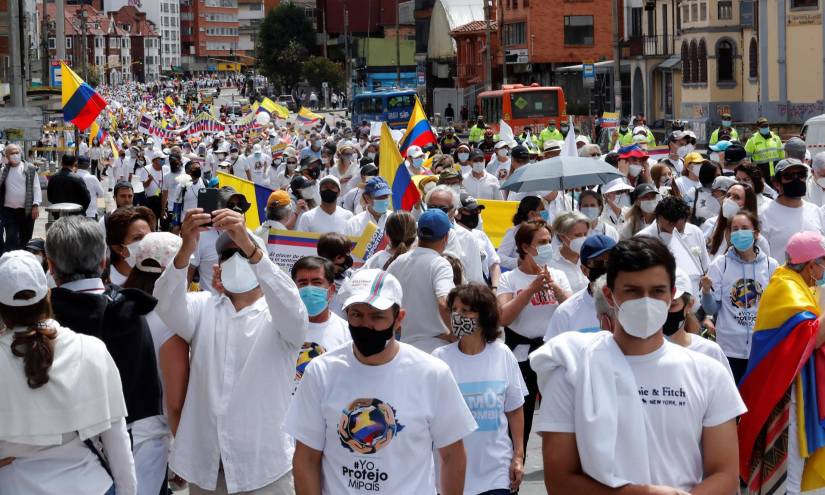RIO DE JANEIRO, BRAZIL – A white tide of thousands of people took to the streets of several Colombian cities on Sunday in protest against the protests that have been taking place in the country since April 28 and against the road blockades and violence that have resulted from the demonstrations.
“We don’t agree with the vandalism or the national strike, it doesn’t represent us,” said Claudia, a financial advisor who participated in the march in Medellin, where thousands of people dressed in white and carrying Colombian flags paraded behind a banner reading “Blockade is a crime!”

Colombia’s second-largest city and fiefdom of Uribism, where there have been hardly any altercations during the protests of recent weeks, today showed its support to the authorities in this way and also to the public force, strongly criticized within the country and by international organizations for the excessive use of force in the repression of the demonstrators.
“We cannot pretend that social protest is confused and becomes a means to impose on society a political program that was defeated at the polls”, considered Luis Guillermo Velez, a university professor who accompanied the march, while cars passed by and whistled in support.
TENSION IN BOGOTÁ
In Bogotá, a demonstration with thousands of people also marched in white shirts along Carrera Séptima, waving Colombian flags and chants such as “We must build Colombia, not destroy it”.
For a Colombia “free of drug traffickers, free of (the FARC guerrillas) and free of the left”, demanded one of the demonstrators.
According to social organizations, other participants handed flowers to the police despite the innumerable criticisms they have received in recent weeks for abuses against protesters that have involved the death of demonstrators and eye injuries, and sexual assaults, according to social organizations.
“I am not against protest, but a healthy protest, without vandalism,” Maria Eugenia, a retiree who said she was “in solidarity” with the people who have been taking to the streets since April 28 “because this country has to be taken forward”, but without vandalism, told Efe during the march.
“I recognize that (those of) my generation went out and got jobs, and for this generation, it is tough,” said the retiree. And it is precisely the age difference that was notorious between today’s demonstrations and those of previous days, where thousands of young people have taken to the streets fed up with the lack of jobs and opportunities and the ever-deepening inequality gap.
“Many of these young people do not work, they do not love their country, they prefer a subsidized country, a country given away. There is a group called nini, they neither work nor study, and they have taken that as a challenge to destroy and destabilize,” said Alexandra, another protester.
In humble neighborhoods of Cali, the epicenter of the protests, such as Siloé or the renowned Puerto Resistencia, and in Bogotá, such as Portal de las Américas, many of those young people referred to by Alexandra have adopted another “ni” and describe that they neither study nor work because they assure that they have no opportunities, but they are not afraid either.
INTERNATIONAL CONCERN
The UN High Commissioner for Human Rights (UNHCHR) office has received reports that 14 people were killed and 98 injured -54 by gunfire- in Cali on Friday, and therefore, expressed its concern from Geneva.
“These events are very worrying after the progress that was being made to resolve the social unrest through dialogue,” said the high commissioner, Michelle Bachelet, who demanded that all those who caused deaths or injuries, including state officials, be investigated and punished according to their responsibility.
The Police acknowledged yesterday the presence of civilians who “used firearms indiscriminately against other people” and assured that they would investigate the agents who were present there and “omitted their duty to prevent these events from occurring and to capture these people”.
After the UN, the European Union, and several countries called on Saturday for a serious dialogue as a solution to the crisis, this Sunday, the Inter-American Commission on Human Rights (IACHR) lamented the violence and expressed its concern over reports of attacks on demonstrators with firearms.
CALM AND CLEAN DAY IN CALI
This Sunday, calm reigned for the second day in Cali, militarized since Saturday. At the same time, the authorities announced the unblocking of several sectors of the city that remained under siege and where the garbage collection service was reestablished, and the collection of debris from the riots began.
Also arrived last night 600 trucks with food and supplies and almost one million tankers with fuel to supply the city, as reported today by the Presidency.
The NGO Temblores and the Instituto de Estudios para el Desarrollo y la Paz (Indepaz) have counted 60 deaths during last month’s protests in Colombia, 43 of which are attributed to the security forces. Of the total number of deaths, 39 took place in Cali, most of them in the first week of protests.
The Attorney General’s Office, on the other hand, counts 43 deaths. However, only “17 of them are directly related to the protests” and is still looking for 123 people reported missing during the demonstrations.

